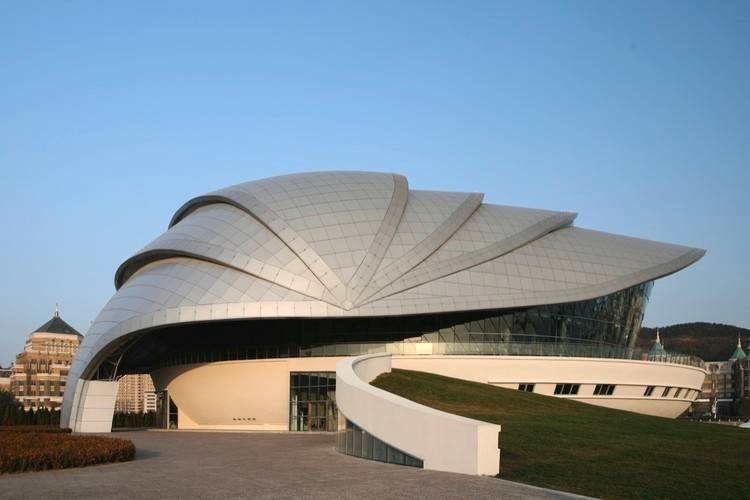
Salvador Dalí
With Starfish and Shells
For anyone who has ever been to the beach, collecting seashells is a staple of summertime. A right of passage for children and a calming activity for adults, there is something about finding the perfectly whole, unique specimen washed ashore amongst a vast spread of beach that feels like uncovering buried treasure. Artists, designers, and architects must feel this intriguing sense of mystery and adventure encapsulated in seashells too, as many of them have allowed their inspiration to be guided by the sounds of the ocean that shells echo when pressed against one’s ear.
The fashion world’s love affair with seashells dates back to 1950s Paris, when costume and set-designer Janine Janet first decorated the store windows of Cristobal Balenciaga’s Avenue George V boutique with seashell-encrusted sculptures, such as a Bust of Neptune, a Shell Elephant and life-size figures covered in Jet and Coral.
Throughout the forthcoming decades, seashells migrated from store windows to high fashion runways when Tunisian couturier Azzedine Alaïa began incorporating shells as a form of delicate ornamentation on couture designs in the latter 1980s. Furthermore, for spring/summer 1990, Alaïa presented a collection of seashell-embellished garments and leather accessories, weaving miniature “coffee bean trivia” shells atop dresses, belts, sandals and wedges. Likewise, for spring/summer 1992, Italian designer Gianni Versace showed an under the sea-themed collection, composed of baroque starfish and seashell prints, as well as over-the-top eveningwear accessorized with marine motif metal jewelry and shell-encrusted heels. A hallmark collection of the late designer’s that was recently revived for spring/summer 2018 by the brand’s creative director, Donatella Versace.
Janine Janet
Bust in Jet and Coral, 1950s
Janine Janet for Balenciaga
Bust of Neptune, 1950
Azzedine Alaïa
Spring/Summer 1990
Azzedine Alaïa
Spring/Summer 1990
Azzedine Alaïa
Spring/Summer 1990
Azzedine Alaïa
Spring/Summer 1990
Azzedine Alaïa
Heeled Shell Sandals
Versace
Spring/Summer 1992
Versace
Spring/Summer 1992
Versace
Spring/Summer 2018
Versace
Spring/Summer 2018
While both Alaïa and Versace’s seashell designs have been reintroduced by their respective houses numerous times since their debut in the early 90s, becoming brand staples in the process, it is Alexander McQueen whose couture shell creations are perhaps the most iconic to ever grace the runway. McQueen’s famed 'VOSS' collection from spring/summer 2001 featured three shell-encrusted garments that highlighted a variety of underwater creatures; namely, the designer’s Razor Clam Dress, Mussel Bodice, and Shell Dress. The former was made of stripped and varnished razor clam shells, secured to a sleeveless gown that reached from the neck to the floor. In keeping with McQueen’s obsession with sea-dwelling objects, the Mussel Bodice also featured a gorgeous high collar encrusted with mussel shells creating a scale-like texture. Likewise, the collection’s Shell Dress was composed of rows of opalescent oyster shells secured to an A-line skirt, layered beneath an overdress made from panels of a 19th century Japanese screen.
Alexander McQueen
Razor Clam Dress, Spring/Summer 2001 (Voss)
Alexander McQueen
Razor Clam Dress, Spring/Summer 2001 (Voss)
Alexander McQueen
Mussel Bodice, Spring/Summer 2001 (Voss)
Alexander McQueen
Shell Dress, Spring/Summer 2001 (Voss)
Alexander McQueen
Oyster Dress, Spring/Summer 2003 (Irere)
Alexander McQueen
Spring/Summer 2012
Alexander McQueen
Spring/Summer 2012
Alexander McQueen
Spring/Summer 2012
Alexander McQueen
Spring/Summer 2012
Alexander McQueen
Spring/Summer 2012
Alexander McQueen
Spring/Summer 2012
For spring/summer 2003, McQueen returned to seashells, this time utilizing the natural form of an Oyster, as opposed to the physical material, as inspiration for a dress composed of strips of nude organza draped on the bias. McQueen’s Oyster Dress merged couture craftsmanship with ideas of decay and disaster. The dress’s descending ruffles resemble stacked oyster shells, while the material’s frayed ends and the skirt’s lush appearance mimics the movement of waxing and waning waves. Over a decade later, creative director Sarah Burton’s spring/summer 2012 collection for the house paid homage to McQueen’s oceanic enthusiasm. Burton presented short, tutu-style dresses and long gowns layered with embroidered organza mimicking the appearance of shells, coral, and sea creatures, which walked amongst extravagant silver dresses resembling piled oysters. Real shells were featured on select ensembles, as well as shell headpieces and masks. The collection hit all of McQueen’s marks and arose as a stunning continuation of the late designer’s legacy.
Prada
Fall/Winter 2017
Prada
Fall/Winter 2017
Prada
Fall/Winter 2017
Prada
Fall/Winter 2017
Balenciaga
Black Seashell Minaudiere Bag, Fall/Winter 2019
Balenciaga
Blue Seashell Minaudiere Bag, Fall/Winter 2019
Chanel
Spring/Summer 2019
Numerous fashion houses have favored the Alaïa route of under-the-sea influence, using seashells as ornamentation on accessories and the inspiration behind uniquely shaped handbags. For fall/winter 2017, Miuccia Prada featured shell necklaces wrapped with gold wire and fixed to gold hardware. The pieces were layered atop oneanother and styled on men and women, nestled amongst crochet bikini tops and sweaters that reflected the collection’s 1970s aesthetic. Most recently, Balenciaga creative director Demna Gvasalia showed shell-shaped purses of duchess satin with pearl straps for fall/winter 2019, while Karl Lagerfeld sent hard, white shell-shaped bags down Chanel’s spring/summer 2019 sand-covered runway, emblazoned with the brand’s double-C logo.
Chanel
Spring/Summer 2012
Chanel
Spring/Summer 2012
Chanel
Spring/Summer 2012
Chanel
Runway Set Design, Spring/Summer 2012
Rodarte
Spring/Summer 2015
Rodarte
Spring/Summer 2015
Rodarte
Spring/Summer 2015
Rodarte
Spring/Summer 2015
Rodarte
Spring/Summer 2015
This was hardly Lagerfeld’s first foray into seashells as inspiration for his work at Chanel. For spring/summer 2012, the late German designer addressed the theme in greater totality, presenting beaded shell handbags amongst a set resembling a serene, all-white grotto, staged with large-scale models of coral, shells, and fish. The atmosphere created a mix of futuristic and underwater themes, examining ideas of natural and artificial, and the manners in which modern design copies nature.
Similarly, for spring/summer 2015, Kate and Laura Mulleavy of Rodarte showed an underwater-themed collection inspired by their childhood memories of tide pools in Monterey, California. With reflective floors designed to echo the water, the collection included dresses with shells caught in netting that resembled fish traps, overlaid diagonally atop sequined mesh skirts.
Grotto Chair
Shell Back and Seat
Grotto Furniture
Various Iterations
Armand-Albert Rateau
Jeanne Lanvin’s Bathroom Sink in Grotto Style, 1924
Seaside inspiration has historically carried into furniture design, as well. Coveted by collectors today, Venetian Grotto furniture famously utilized the shape of shells, often gilded in gold or iridescent materials, as forms for chairs and sofas. The 19th century European movement had great influence on later furniture design, particularly in the work of Armand-Albert Rateau, who sought inspiration from early Grotto furniture when designing Jeanne Lanvin’s bathroom in 1924. The sink, made of marble, bronze, glass, plaster, and stucco, had a hand-carved base to resemble the shape of a seashell.
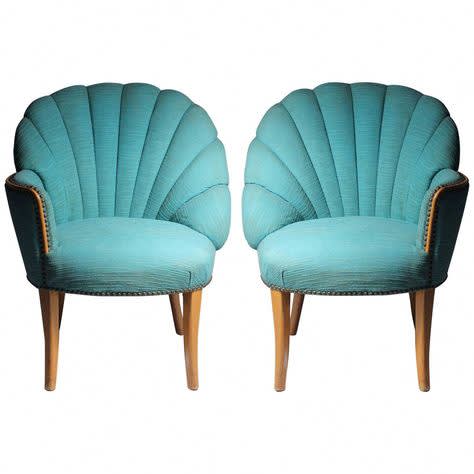
Shell Back Arm Chairs
Art Deco, 1920s
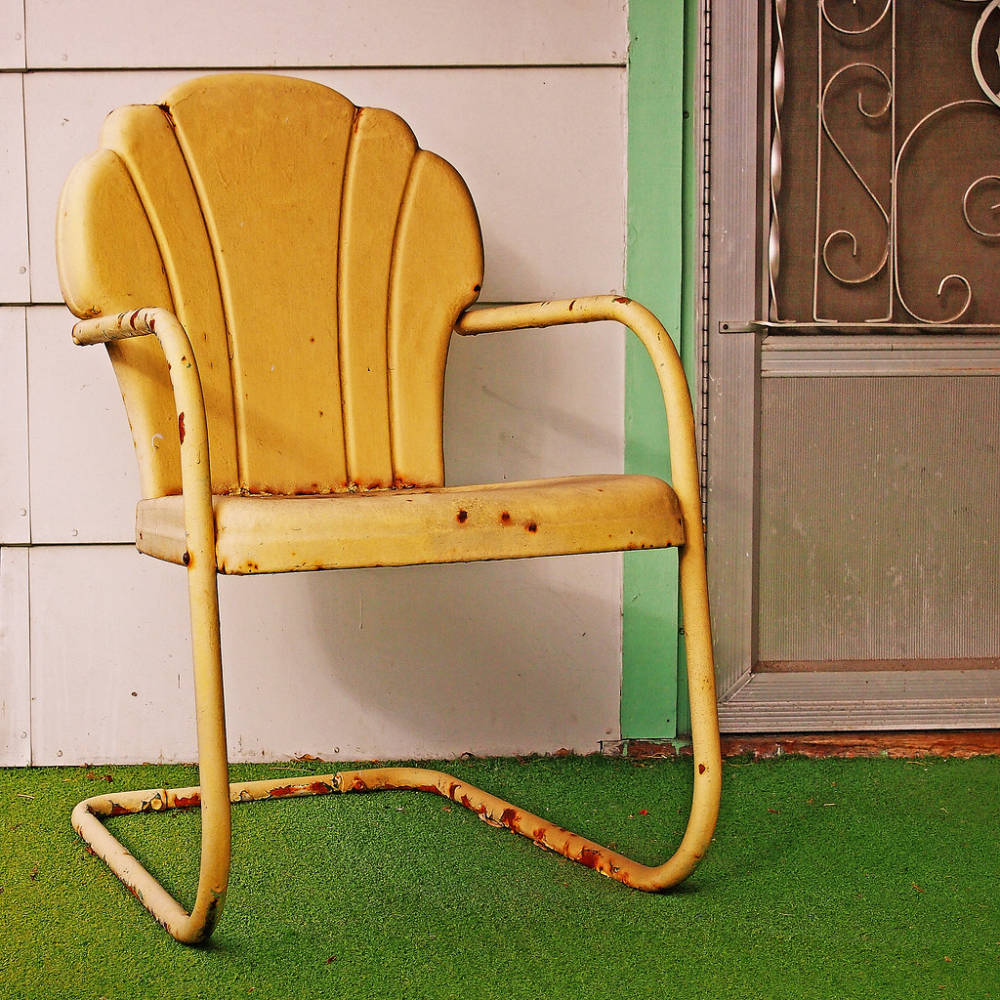
Shell Lawn Chair
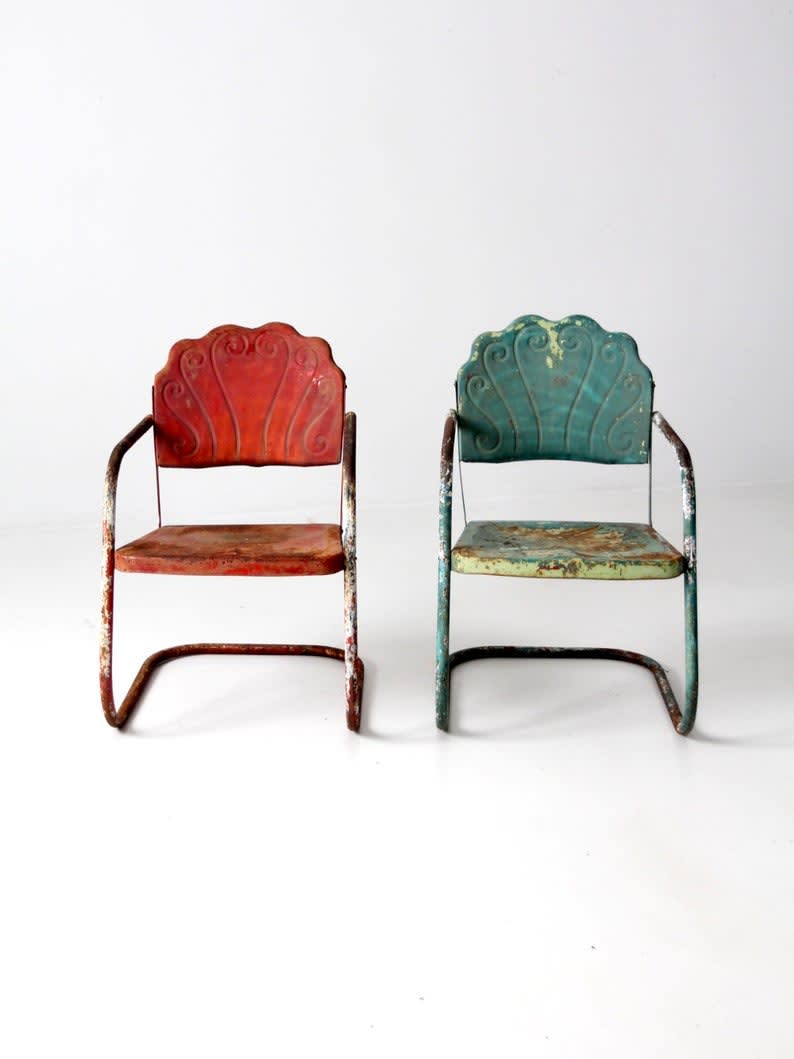
Shell Lawn Chair
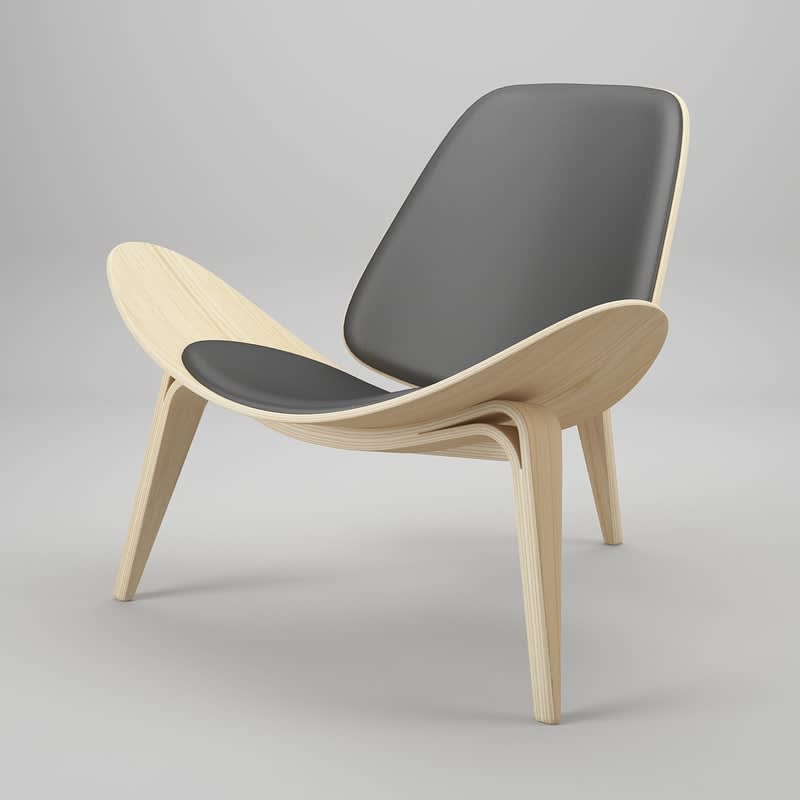
Hans J. Wegner
Shell Chair, 1963

Tiffany & Co.
'Strawberry' Pattern Antique Sterling Silver Scallop Shell Serving Spoon, 1900

Tiffany & Co.
Sterling Silver Shell Plate
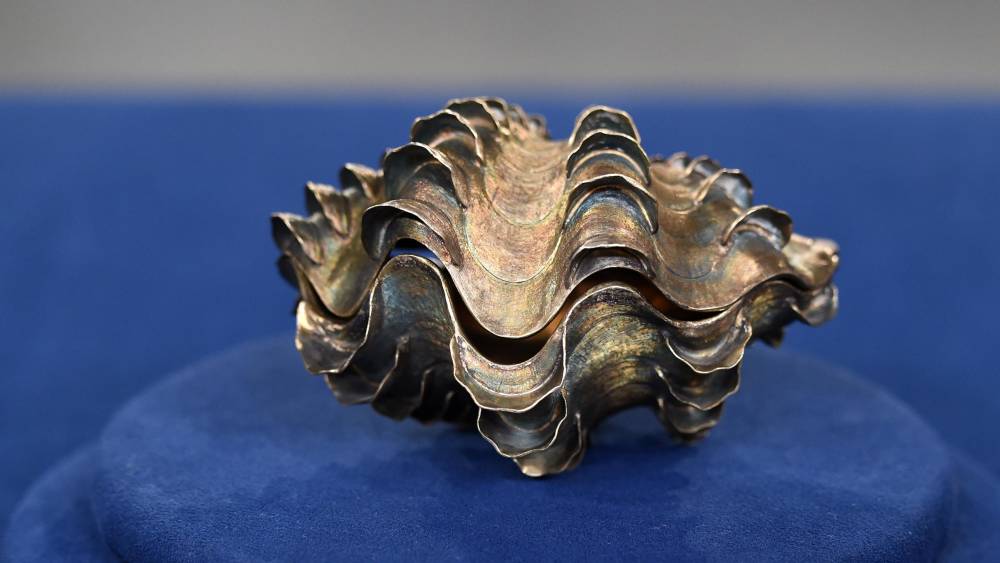
Tiffany & Co.
Decorative Clam Shell, 1965
Shell chairs continued to gain popularity throughout the 20th century, with several iterations appearing over the years. The 1920s, appropriately, saw art deco-inspired velvet upholstered living room chairs with shell-shaped backs and wooden legs, while mid-century American design saw the rise of shell-backed lawn chairs, often made of steel and sheet metal. These inexpensive seating designs were perfect for the new middle class arising throughout the country, mirroring the identical houses rapidly springing up across American suburbs. Likewise, in 1963, Hans J. Wegner designed the ahead-of-its-time CH07 Shell Chair with sleek modern legs and a wide curving seat, a design that is now considered iconic.
Pre-dating the art deco shell furniture movement, in 1900 Tiffany & Co. released a series of shell-inspired pieces for the home. Made of sterling silver, the collection included a dish, nut dish, penholder, and spoon. Meanwhile, in 1965, Tiffany’s released a beautiful, decorative sterling silver clamshell, which is still coveted today.
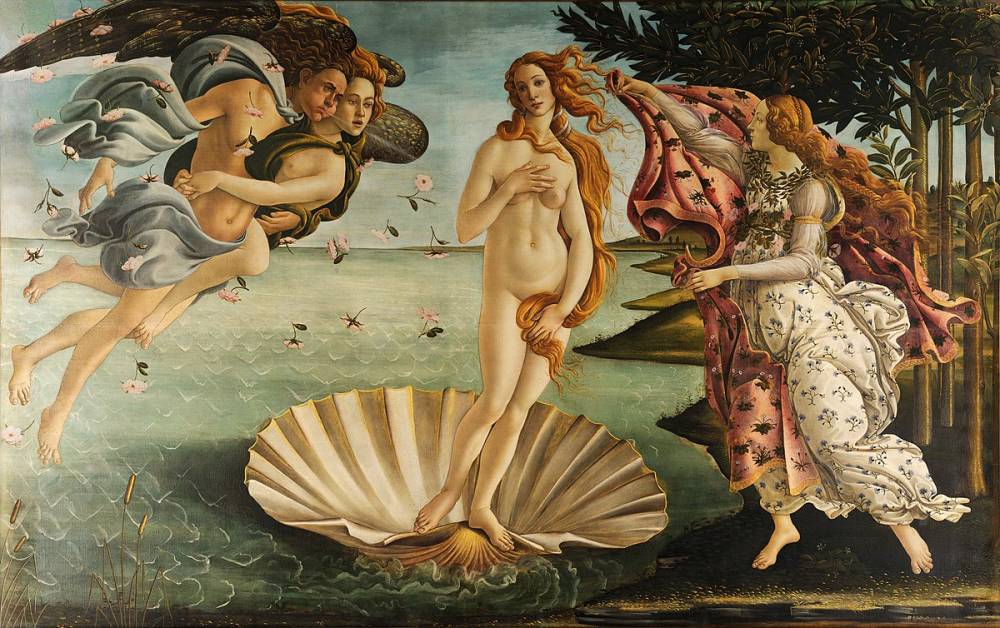
Sandro Botticelli
The Birth of Venus, 1485-1486
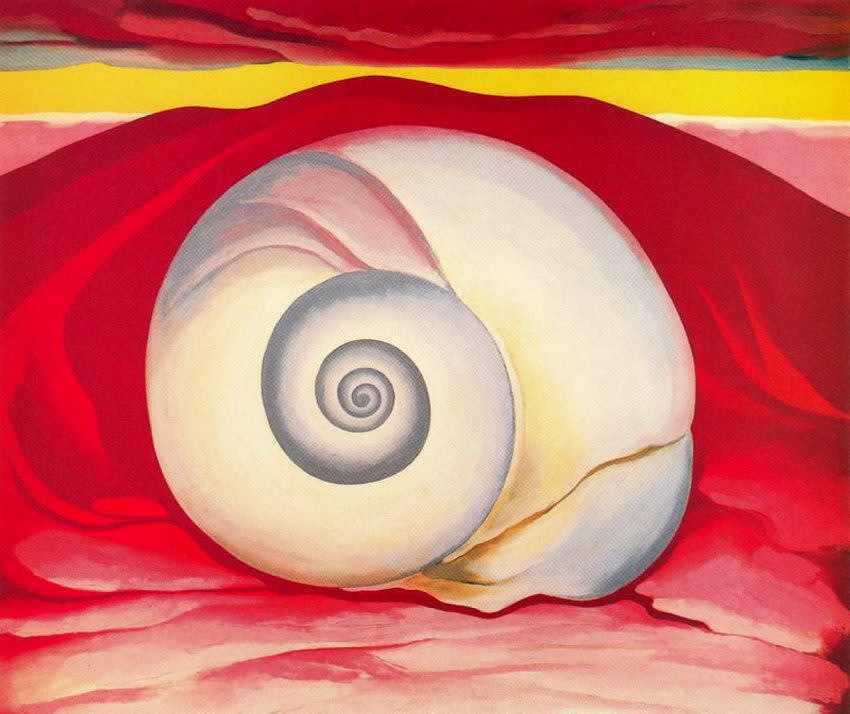
Georgia O'Keeffe
Red Hill And White Shell, 1938
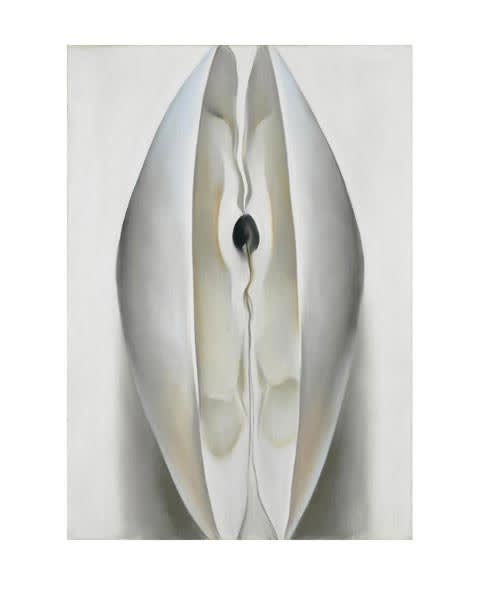
Georgia O'Keeffe
Slightly Open Clam Shell, 1926
The most glaring and hallmark example of seashells throughout art history is Botticelli’s late 15th century painting, The Birth of Venus, in which the Goddess Venus stands nude in a giant scallop shell. Completed in the 1480s, the painting is one of the most important and recognizable works to emerge from the Italian Renaissance.
Centuries later, American artist Georgia O’Keeffe created several works sexualizing the organic shapes of seashells. O’Keeffe’s 1938 painting, “Red Hill and White Shell,” depicts a sleek crustacean against a rich, warm colored background inspired by the landscape of New Mexico, while a decade earlier, O’Keeffe created stunning white pastel images such as, “Clam Shell” and “Slightly Open Clam Shell”.

Salvador Dalí
Shell, 1928
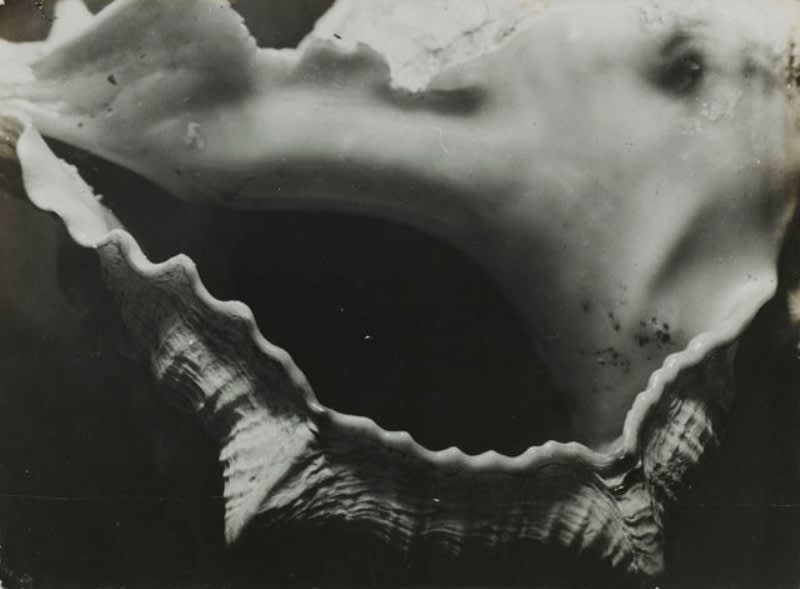
Salvador Dalí
Coquillage, 1933
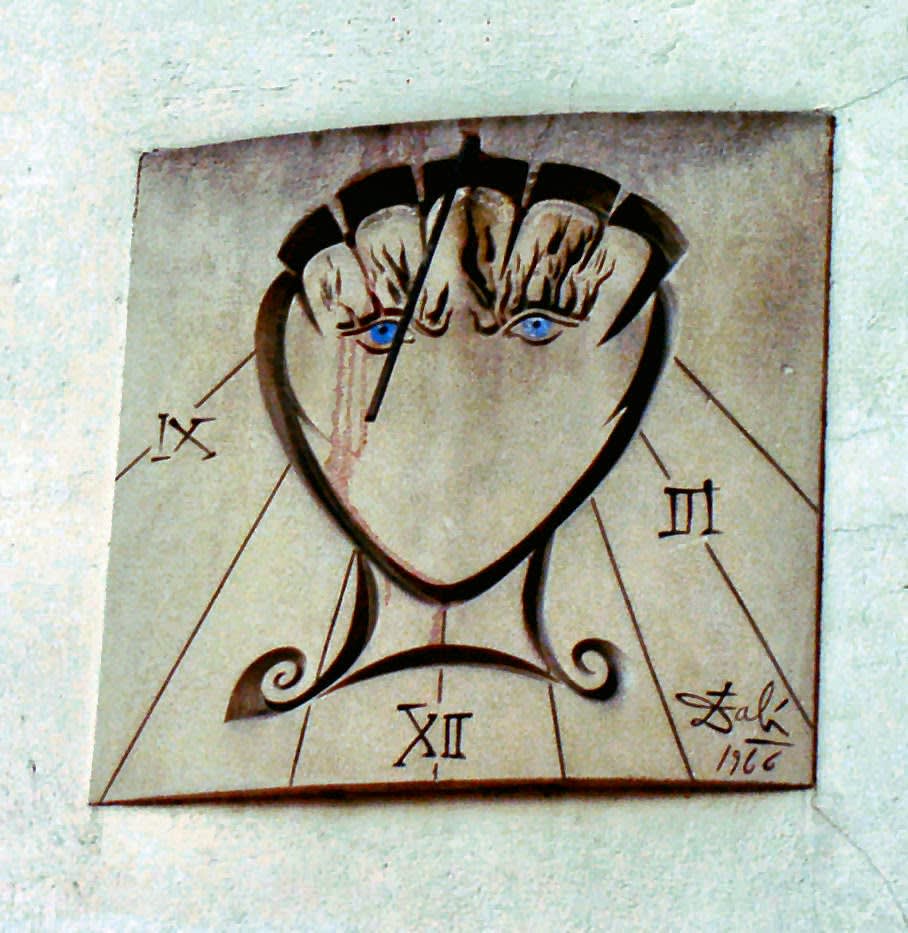
Salvador Dalí
Scallop Shell Sundial, Rue Saint-Jacques, Paris
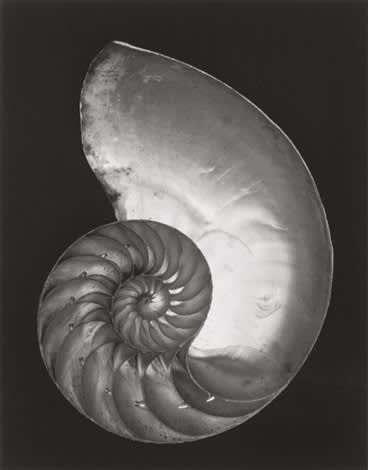
Edward Weston
Shell, 1927
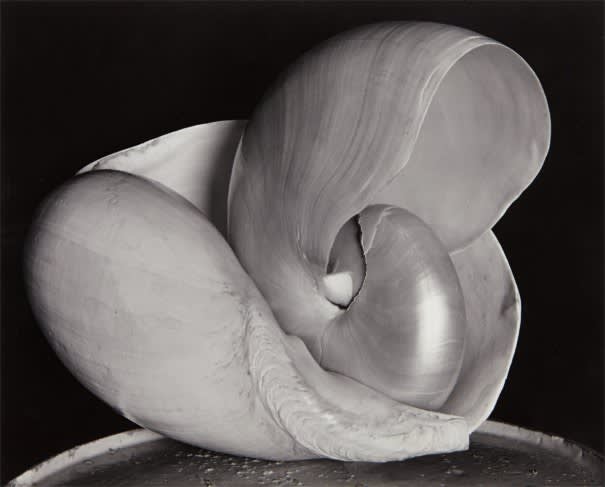
Edward Weston
Shells, 1927

Pablo Picasso
The Scallop Shell, Notre Avenir est dans l'Air, 1912
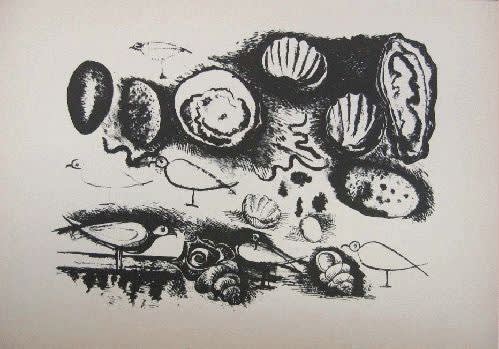
Pablo Picasso
Shells and Birds, 1946
Salvador Dalí, too, was drawn to seashells throughout his vast career. A collector of shells and other sea-dwelling objects, Dali took photographic self-portraits posing with his treasures. In 1928, Dalí painted “Shell,” featuring a conch set against a dark night sky, while a 1933 photograph by the artist depicts a close-up of a shell’s opening. Dalí even designed a scallop shell sundial sculpture which is located on the facade of a building on Rue Saint-Jacques in Paris.
In the 1920s, American photographer Edward Weston produced a series of shell photographs shot against stark black backgrounds, emphasizing both the beauty and geometry of these natural specimens. Likewise, Pablo Picasso’s 1912 painting, “The Scallop Shell, Notre Avenir est dans l’Air,” depicts shells peaking through Picasso’s cubist style canvas, while a 1946 charcoal drawing, “Shells and Birds,” shows the artist’s deep connection between seashells and nature.

Eero Saarinen
TWA Flight Center, 1962

Eero Saarinen
TWA Flight Center, 1962

Eero Saarinen
Kresge Auditorium, 1955

Eero Saarinen
Kresge Auditorium, 1955

Eero Saarinen
Kresge Auditorium, 1955
Architects, too, have looked to shells for inspiration when designing buildings. The Shell Structure, first introduced in the 1920s, refers to a thin curved plate stiffened by ribs often constructed from concrete and steel mesh. This lightweight system – often forming large overhanging roofs – can span up to 300 feet in diameter and gained long-term popularity after World War II. Examples of this design technique can be found in the TWA Flight Center at JFK Airport and MIT’s Kresge Auditorium, both designed by architect Eero Saarinen. Other notable shell structures include Los Manantiales in Valencia designed by Felix Candela, Capela Bosjes, designed by Steyn Studio, and the Sydney Opera House, designed by Jørn Utzo of British engineering firm Arup Group. Even the Shell Museum in Dalian, China projects its collection of precious seashells onto the design of its building, through a unique, shell-shaped façade.
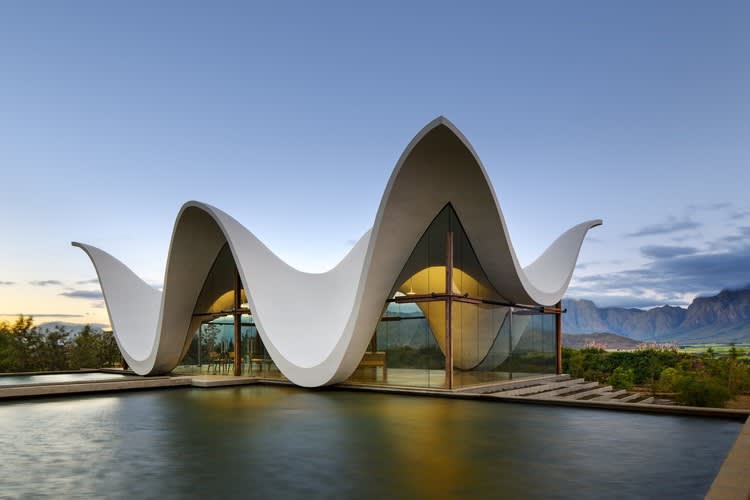
Steyn Studio
Capela Bosjes, 2017

Steyn Studio
Capela Bosjes, 2017
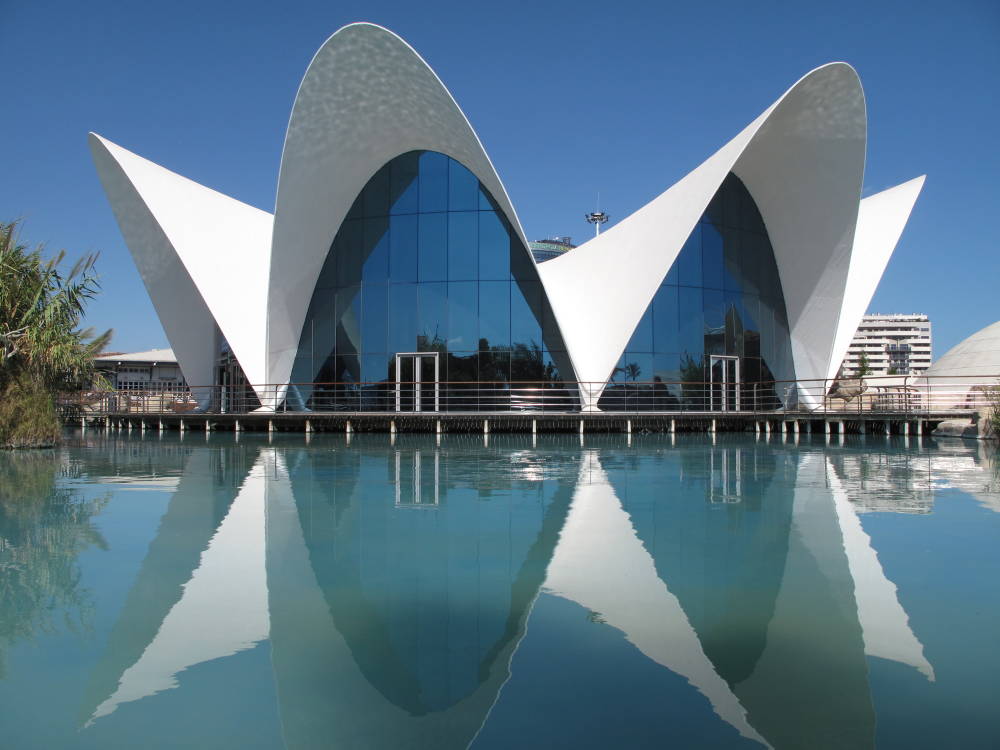
Felix Candela
Los Manantiales, Valencia Spain
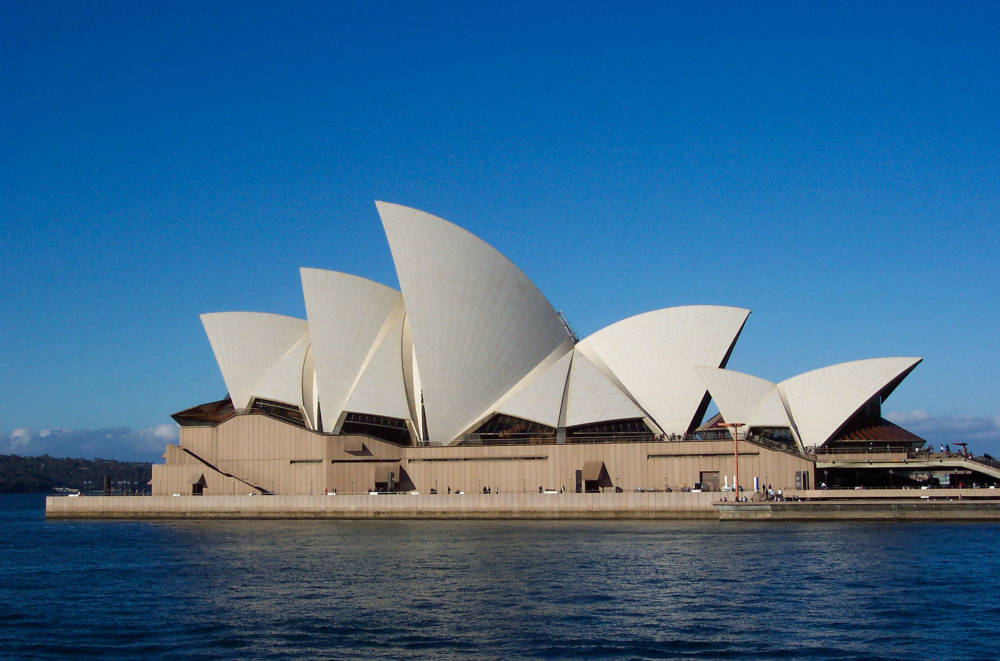
Jørn Utzo
Sydney Opera House
